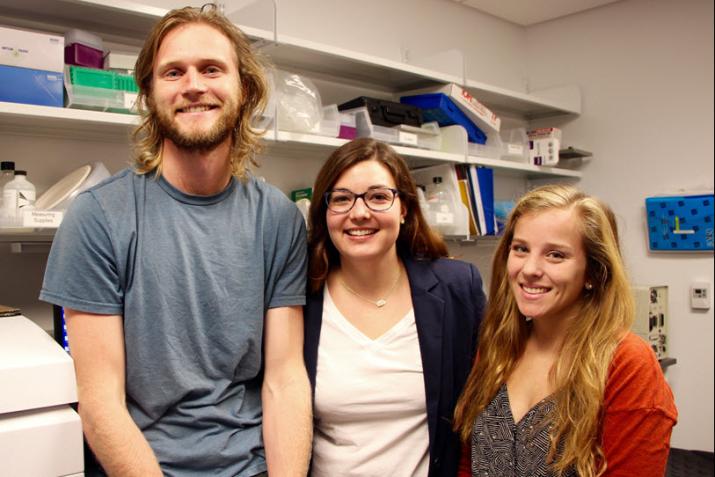
Robert Morhard, Jenna Mueller (a DGHI doctoral certificate alumna) and Corrine Nief are working to develop an enhanced ethanol ablation strategy to treat precancerous lesions on the cervix.
Published December 5, 2017, last updated on April 6, 2020 under Research News
Robert Morhard, a PhD student in biomedical engineering and a DGHI doctoral scholar, wants to create a therapy to treat cervical cancer precursors.
He’s in the right place to pursue this challenge, working under the mentorship of biomedical engineering and global health professor Nimmi Ramanujuam and David Katz, a biomedical engineering professor.
Since 2012, Ramanujam has led the development of a low-cost portable device, the Pocket Colposcope, to increase access to cervical cancer screening in primary care settings in low-resource communities. One of her long-term goals is to discover a cost-effective cervical cancer treatment that will take women in these communities beyond screening and diagnosis—and save their lives.
To that end, Katz, Ramanujam, Morhard and other students in Ramanujam’s lab have been studying how precancerous lesions could be removed from the cervix using an ethanol-based formulation. While previous studies have shown that ethanol can kill tumor cells, the researchers also needed a way to keep the liquid in place: “It needs to be localized in the target region so it can do its job,” says Katz, “and to avoid damaging healthy tissue nearby.”
The method could cost less than one dollar per treatment and could be implemented without electricity, specialized equipment or hard-to-supply consumables.
The team decided to use ethyl cellulose, which dissolves in ethanol and increases the liquid’s viscosity, making it thicker and more effective at ablating the tumors. But one day, as Morhard was cleaning out the storage containers for the liquid, he made a strange discovery.
“After doing a few experiments, I was cleaning out the containers and I noticed that when I added water, a white gel formed,” he says. “We hadn’t realized until that point that since ethyl cellulose is not water-soluble, it forms a white gel when it’s mixed with water.”
This accidental discovery proved to be an advantageous development for the treatment.
“Our main issue with this treatment is ensuring that the injected ethanol stays localized around the injection site to increase efficacy,” says Morhard. “The longer the ethanol concentration is elevated within the treatment site, the more likely the cells will die. The fact that this ethyl cellulose-ethanol solution is consistently effective is likely due to this gel formation.”
Along with these positive developments, the team is optimistic about how this new approach could be deployed in resource-limited settings worldwide. The method could cost less than one dollar per treatment and could be implemented without electricity, specialized equipment or hard-to-supply consumables. Thus, it would be useful in a multitude of healthcare settings––including mobile clinics that use the Pocket Colposcopes to help identify women at risk of cervical pre-cancer and cancer.
Although the research still has a long road to reach the clinic, the team has established a proof-of-concept study and recently published their first findings in Scientific Reports, a Nature research journal. Next, they plan to conduct safety trials in other scientific models, while they refine details of the injection process and then design an injection device suitable for the same global settings in which the Pocket Colposcope is applied.
Learn More:
- Read about the Pocket Colposcope.
- Read Morhard's Scientific Reports article.
- Learn about other biomedical engineering global health initiatives at Duke.
This article was excerpted and adapted from a piece originally published on Duke’s Biomedical Engineering website and was published with permission.


